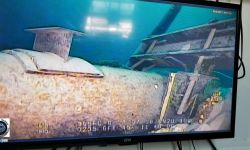Michigan officials urge residents not to transport firewood

- Untreated firewood may be infested with oak wilt fungus or beech bark disease or harbor egg masses from invasive pests
- When wood is transported from place to place, these diseases and pests can cause widespread damage
- The DNR is encouraging residents to buy firewood within 50 miles of where they plan to burn it
As camping season is underway and people are burning campfires to stay warm at night or lighting their fireplaces, state officials are encouraging residents to “burn where you buy.”
Moving firewood from one place to another can increase the chances of diseases and pests spreading and causing damage.
Firewood can appear harmless but can carry threats not visible to the naked eye, including spongy moth and spotted lanternfly egg masses and diseases like oak wilt fungus or beech bark disease.
Related:
- Invasive spotted lanternfly confirmed in Michigan — second time since 2022
- Michigan warns residents to report invasive Asian longhorned beetle
- Inside the Michigan lab where scientists raise killer bugs to save trees
“One of the big concerns with moving firewood is that people think that, ‘oh, you know, it's fine. It's right in my backyard. It should be safe to move,’ but actually there are a lot of insects and tree diseases that can be moved by firewood, things that you may not even see with the naked eye,” said Joanne Foreman, communications specialist for the state’s invasive species program.
Invasive species typically don’t move far on their own but can travel hundreds of miles on infested firewood, according to the Michigan Department of Natural Resources.
“The biggest thing that moves them is humans and firewood is probably one of the easiest ways to unwillingly, unwittingly move those diseases or insects,” Foreman said.
The DNR recommends buying firewood within 50 miles of where you live or where you plan to burn it.
Even if you buy firewood and don’t use it, it’s still not safe to travel with it. Only certified, heat-treated firewood can travel long distances because it has been heated to kill insects and diseases.
Certified heat-treated firewood will have a federal stamp or seal on the package.
Michigan Environment Watch
Michigan Environment Watch examines how public policy, industry, and other factors interact with the state’s trove of natural resources.
- See full coverage
- Subscribe
- Share tips and questions with Bridge environment reporter Kelly House
Michigan Environment Watch is made possible by generous financial support from:
Our generous Environment Watch underwriters encourage Bridge Michigan readers to also support civic journalism by becoming Bridge members. Please consider joining today.
See what new members are saying about why they donated to Bridge Michigan:
- “In order for this information to be accurate and unbiased it must be underwritten by its readers, not by special interests.” - Larry S.
- “Not many other media sources report on the topics Bridge does.” - Susan B.
- “Your journalism is outstanding and rare these days.” - Mark S.
If you want to ensure the future of nonpartisan, nonprofit Michigan journalism, please become a member today. You, too, will be asked why you donated and maybe we'll feature your quote next time!






